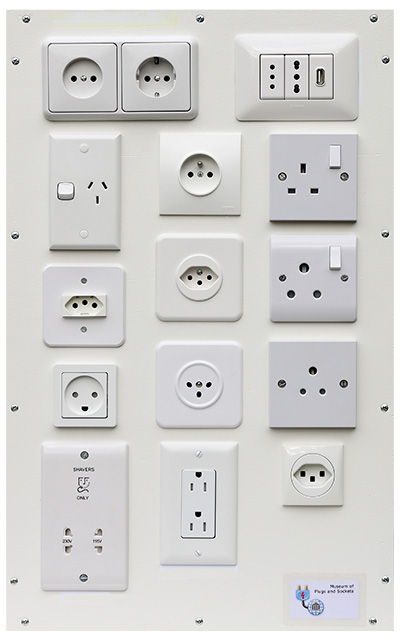 |
Domestic socket standards overview |
Info page |
Map |
| Image left shows a display of
sockets
that
can be found in homes and offices. Some countries allow only one
domestic standard, others have adopted two or more standards*. An overview of countries and standards used is given in the IEC list of World Plugs. Image right shows the outlines of socket standards. Clicking on an outline opens the page that gives examples and details of the standard. Names and basics of standards are summarized below. |
 |
 |
| a |
CEE 7/1**. Unearthed
socket standard, commonly used in continental Europe. The 19 mm spacing
of contacts dates back
to the early twentieth century. 19 mm became in 1924 the German standard for 6A
and 10A
plugs
and sockets. |
| b | CEE 7/3. Sockets that have earth
clips. The original German name is Schuko (see Origin of Schuko page). |
| c | CEI 23/50. Italian standard for 10A
(c1)
and 16A (c2) sockets. Often 10A and 16A contacts are combined; see
Italian socket in the image left. |
| d | AS/NZS 3112. Standard in Australia
and New
Zealand since 1937, based on a 1916 US design that never was approved
by NEMA (National Electrical Manufacturers Association, USA). |
| e | CEE 7/5. The only domestic socket
that has
an earth pin. Often referred to as French type, but a comparison of
manufacturer catalogs suggest that the type was on sale in Belgium
prior to
France. The origin is still a mystery. |
| f | BS 1363. British standard for
"fused plugs
and shuttered socket-outlets", introduced in 1947. In the UK BS 1363
has effectively fully replaced BS 546 (see k) as domestic plug and
socket. |
| g | IEC 60906-1. Proposed in 1986 by
the
International Electrotechnical Commission as the universal household
plug and socket. Brazil introduced in 2002 an adjusted version. South
Africa adopted in 2013 the original IEC standard. |
| h | SN 441011 (formerly SEV 1011). The
10A version (h1) was introduced in 1953, the 16A version (h2) in 1998.
Swiss 10A plugs fit also in 16A sockets (but not the other way round). |
| k | BS 546. British standard of earthed
round pin plugs and sockets that dates back to 1928 (initially BS 317,
renumbered 546 in 1934). Three versions exist: 15A (k1), 5A (k2) and a
small 2A socket (not shown; nowadays uncommon). |
| l | DS 107-2-D1. Danish standard
section for
earthed sockets and plugs. Outline shows the 13A diomestic socket. |
| m | SI 32. Israeli standard. Initially
Israel
had 10A flat pin plugs. In the 1980s they were upgraded to 16A round
pin plugs. Pin spacing remained comparable. The shown 16A socket
accepts both 10A and 16A plugs, but these dual type sockets will
gradually disappear. |
| n | NEMA 5-15R. The prominent domestic
120V -
15A socket (Receptacle) in USA and Canada (see Origin of US plugs and sockets). Occasionally
120V-20A and 240V-15A
sockets can be found in homes, but their straight blade configurations
differ. In the 1940s NEMA, the National Electrical Manufacturers
Association, has defined a large number of US plug and socket standards. |
| o | BS 4573. British, but de facto
international, socket for shavers only, rated at 115-230 Volt - 0.2
Amp. Shaver
sockets accept the following not earthed plugs: British BS 4573,
Europlugs (CEE 7/16), straight blade NEMA 1-15P and Australian type not
earthed flat blade plugs. |
| p | USB type A. 5 Volt DC outlet for
chargers
of portable devices.The USB
image is not clickable. USB outlets are not a part of the museum
collection. It is shown only because it was part of a domestic socket. Most types of domestic socket offer the option of an added USB outlet. |
* |
Countries that accept several standards of domestic plugs may have sockets that can be used for two or more "incompatible" plugs. A variety of dual or more complex multi-standard sockets exists. Some examples are shown on a separate page. |
** |
Publication CEE 7 by the former International Commission on the Rules for the Approval of Electrical Equipment (IECEE) defines standards for alternating current plugs and sockets for domestic and similar purposes. |
| |
D i g i t a l M u s e u m o f | |
P l u g s a n d S o c k e t s | |